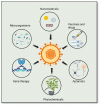The Interplay of Genital Herpes with Cellular Processes: A Pathogenesis and Therapeutic Perspective
- PMID: 38005873
- PMCID: PMC10675801
- DOI: 10.3390/v15112195
The Interplay of Genital Herpes with Cellular Processes: A Pathogenesis and Therapeutic Perspective
Abstract
Genital herpes, primarily caused by herpes simplex virus-2 (HSV-2), remains a pressing global health concern. Its remarkable ability to intertwine with cellular processes, from harnessing host machinery for replication to subverting antiviral defenses like autophagy and programmed cell death, exemplifies the intricate interplay at the heart of its pathogenesis. While the biomedical community has extensively researched antiviral interventions, the efficiency of these strategies in managing HSV-2 remains suboptimal. Recognizing this, attention has shifted toward leveraging host cellular components to regulate HSV-2 replication and influence the cell cycle. Furthermore, innovative interventional strategies-including drug repurposing, microbivacs, connecting the host microbiome, and exploiting natural secondary metabolites-are emerging as potential game changers. This review summarizes the key steps in HSV-2 pathogenesis and newly discovered cellular interactions, presenting the latest developments in the field, highlighting existing challenges, and offering a fresh perspective on HSV-2's pathogenesis and the potential avenues for its treatment by targeting cellular proteins and pathways.
Keywords: antivirals; genital herpes; herpes simplex virus-2; immune response; microbiome; vaccines.
Conflict of interest statement
The authors declare no conflict of interest.
Figures





Similar articles
-
Genital herpes.Best Pract Res Clin Obstet Gynaecol. 2014 Oct;28(7):1098-110. doi: 10.1016/j.bpobgyn.2014.07.015. Epub 2014 Aug 4. Best Pract Res Clin Obstet Gynaecol. 2014. PMID: 25153069 Review.
-
HSV-2 Manipulates Autophagy through Interferon Pathway: A Strategy for Viral Survival.Viruses. 2024 Aug 29;16(9):1383. doi: 10.3390/v16091383. Viruses. 2024. PMID: 39339859 Free PMC article.
-
Flavonoids with Anti-Herpes Simplex Virus Properties: Deciphering Their Mechanisms in Disrupting the Viral Life Cycle.Viruses. 2023 Nov 29;15(12):2340. doi: 10.3390/v15122340. Viruses. 2023. PMID: 38140581 Free PMC article. Review.
-
Therapeutic Mucosal Vaccination of Herpes Simplex Virus 2-Infected Guinea Pigs with Ribonucleotide Reductase 2 (RR2) Protein Boosts Antiviral Neutralizing Antibodies and Local Tissue-Resident CD4+ and CD8+ TRM Cells Associated with Protection against Recurrent Genital Herpes.J Virol. 2019 Apr 17;93(9):e02309-18. doi: 10.1128/JVI.02309-18. Print 2019 May 1. J Virol. 2019. PMID: 30787156 Free PMC article.
-
HSV antivirals - current and future treatment options.Curr Opin Virol. 2016 Jun;18:9-13. doi: 10.1016/j.coviro.2016.01.013. Epub 2016 Feb 19. Curr Opin Virol. 2016. PMID: 26897058 Review.
Cited by
-
Bid Protein: A Participant in the Apoptotic Network with Roles in Viral Infections.Int J Mol Sci. 2025 Mar 7;26(6):2385. doi: 10.3390/ijms26062385. Int J Mol Sci. 2025. PMID: 40141030 Free PMC article. Review.
-
Therapeutic prime/pull vaccination of HSV-2-infected guinea pigs with the ribonucleotide reductase 2 (RR2) protein and CXCL11 chemokine boosts antiviral local tissue-resident and effector memory CD4+ and CD8+ T cells and protects against recurrent genital herpes.J Virol. 2024 May 14;98(5):e0159623. doi: 10.1128/jvi.01596-23. Epub 2024 Apr 8. J Virol. 2024. PMID: 38587378 Free PMC article.
References
-
- Liu F., Zhou Z.H. Comparative virion structuRes. of human herpesviruses. In: Arvin A., Campadelli-Fiume G., Mocarski E., Moore P.S., Roizman B., Whitley R., Yamanishi K., editors. Human Herpesviruses: Biology, Therapy, and Immunoprophylaxis. Cambridge University Press; Cambridge, UK: 2007.
Publication types
MeSH terms
Substances
Grants and funding
LinkOut - more resources
Full Text Sources
Medical

